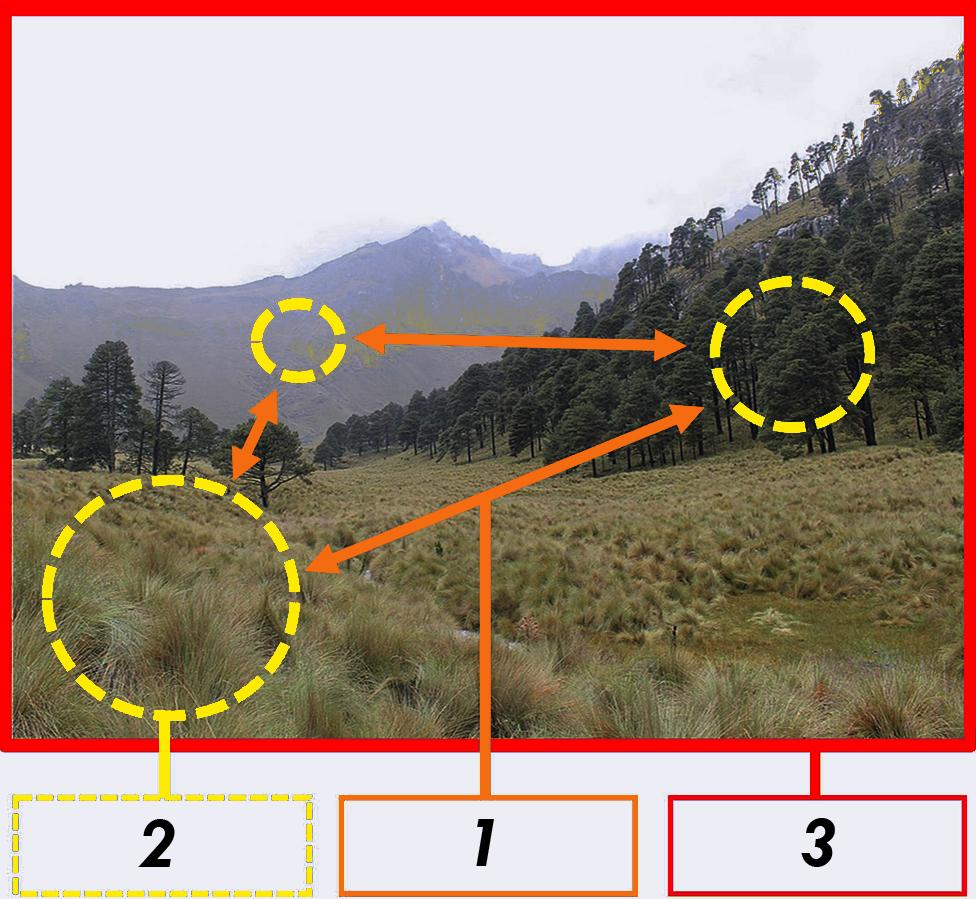
Identify different types of diversity denoted by 1, 2, and 3 in the given figure.

(a) 1 - Alpha diversity, 2- Beta diversity, 3 - Gamma diversity.
(b) 1 - Gamma diversity, 2 - Alpha diversity, 3- Beta diversity.
(c) 1 - Gamma diversity, 2 - Beta diversity, 3 - Alpha diversity.
(d) 1 - Beta diversity, 2 - Alpha diversity, 3 - Gamma diversity.

Answer
447.9k+ views
Hint: Diversity refers to the different types of areas having different types of species or sometimes the species belonging to various groups are found in the same geographical area or habitat. These diversities of various types.
Complete answer:
The term alpha diversity means different species that are found in the local habitats or sites. It includes both the local area of habitats and landscape that include these species. It varies from units to units that may also include the different sampling units. These sampling units may already be used in the field or maybe the new one. By the study of these in small areas, we can find the species diversity of various species present in the larger areas.
Beta diversity is all about the study of species in regional areas. It also detects the ratio between the regional and the local species diversity. It tells about the total species diversity in a particular area which is dependent upon the mean of species diversity at habitat level. It can be estimated by observing the similarities and differences between the two communities along with overlapping of the samples. It can be seen in between the woodland and the hedgerow habitat, as the species present in the woodland habitat ate not found in the hedgerow habitat, and the species present in the hedgerow habitat are absent in the woodland habitat.
Gamma diversity is the total diversity of species present in a landscape. It depends upon the mean diversity of the species and the local habitat of the species. By finding the difference between the alpha diversity and the beta diversity we can easily calculate the gamma diversity. For calculating gamma diversity no specific spatial scales are required but they can be calculated by any unit of scale.
So, the correct answer is ‘1 - Beta diversity, 2 - Alpha diversity, 3 - Gamma diversity’.
Note:
The terms alpha, beta, and gamma diversity were introduced by R.H. Whittaker. According to him, diversity is of three types: alpha diversity (species diversity present within each forest, grassland, or a community), beta diversity (species diversity present between any two communities), and gamma diversity (species diversity along with the entire range of mountain slope).
Complete answer:
The term alpha diversity means different species that are found in the local habitats or sites. It includes both the local area of habitats and landscape that include these species. It varies from units to units that may also include the different sampling units. These sampling units may already be used in the field or maybe the new one. By the study of these in small areas, we can find the species diversity of various species present in the larger areas.
Beta diversity is all about the study of species in regional areas. It also detects the ratio between the regional and the local species diversity. It tells about the total species diversity in a particular area which is dependent upon the mean of species diversity at habitat level. It can be estimated by observing the similarities and differences between the two communities along with overlapping of the samples. It can be seen in between the woodland and the hedgerow habitat, as the species present in the woodland habitat ate not found in the hedgerow habitat, and the species present in the hedgerow habitat are absent in the woodland habitat.
Gamma diversity is the total diversity of species present in a landscape. It depends upon the mean diversity of the species and the local habitat of the species. By finding the difference between the alpha diversity and the beta diversity we can easily calculate the gamma diversity. For calculating gamma diversity no specific spatial scales are required but they can be calculated by any unit of scale.
So, the correct answer is ‘1 - Beta diversity, 2 - Alpha diversity, 3 - Gamma diversity’.
Note:
The terms alpha, beta, and gamma diversity were introduced by R.H. Whittaker. According to him, diversity is of three types: alpha diversity (species diversity present within each forest, grassland, or a community), beta diversity (species diversity present between any two communities), and gamma diversity (species diversity along with the entire range of mountain slope).
Latest Vedantu courses for you
Grade 11 Science PCM | CBSE | SCHOOL | English
CBSE (2025-26)
School Full course for CBSE students
₹41,848 per year
EMI starts from ₹3,487.34 per month
Recently Updated Pages
Master Class 4 Maths: Engaging Questions & Answers for Success

Master Class 4 English: Engaging Questions & Answers for Success

Master Class 4 Science: Engaging Questions & Answers for Success

Class 4 Question and Answer - Your Ultimate Solutions Guide

Master Class 11 Economics: Engaging Questions & Answers for Success

Master Class 11 Business Studies: Engaging Questions & Answers for Success

Trending doubts
Give 10 examples of unisexual and bisexual flowers

Draw a labelled sketch of the human eye class 12 physics CBSE

a Tabulate the differences in the characteristics of class 12 chemistry CBSE

Differentiate between homogeneous and heterogeneous class 12 chemistry CBSE

Why is the cell called the structural and functional class 12 biology CBSE

Differentiate between insitu conservation and exsitu class 12 biology CBSE




